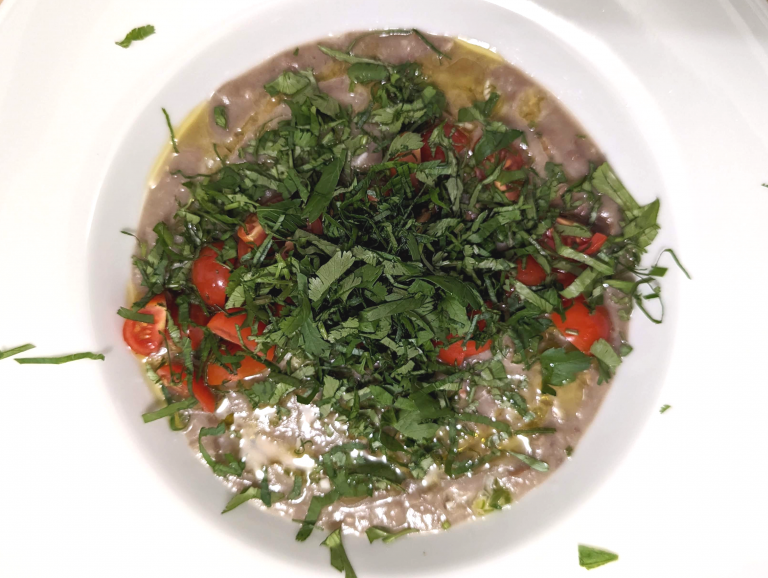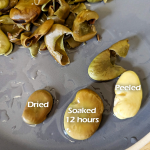Egyptian Fava Beans
Recipe first, story last.
Warning: Beware of favism. It’s rare, but there is an allergic reaction to fava beans for people who lack an enzyme called G6PD which occurs mostly among people of African, Mediterranean, or Asian descent. Call a doctor if you start to feel nausea, headaches, stomach, fever, have a faster heart rate, darker urine, or jaundiced skin.

INGREDIENTS:
1 cup dried fava beans
½ cup water
Kosher salt
½ to 1 teaspoon ground cumin
1 to 2 hot peppers, chopped (jalapenos will work here)
2 garlic cloves, chopped
1 large lemon juice of
Extra virgin olive oil (Early Harvest)
1 cup chopped parsley
1 tomato, diced
SERVE WITH:
Warm pita bread
Sliced tomatoes
Sliced cucumbers
Green onions
Olives…
and anything else you fancy that would go with beans
Directions:
- Soak dried beans in plenty of water overnight. The skin should peel off easily. If not, they need more soaking time.
- Drain the soaking water & peel the skins.
- Then, place beans in a pot with fresh water, bring to a boil, and then bring it down to a simmer for about an hour or until the beans are tender.
- In a cast iron skillet or saucepan, add the fava beans and ½ cup water. Warm over medium-high heat.
- Season with kosher salt and cumin. Use a potato masher or fork to mash the fava beans.
- In a mortar and pestle, add the hot peppers and garlic. Smash.
- Add in juice of one lemon and stir to combine.
- Pour the garlic and hot pepper sauce over the fava beans. Add a generous drizzle of extra virgin olive oil.
- Top with chopped parsley, diced tomatoes, and a few slices of hot peppers, if you like.
- Serve with pita bread, sliced veggies and olives.
Story:
STORY:
Years ago, a relative of mine was telling me about his early days working on a field somewhere on the African continent. Maybe Sudan? A lot of his stories involved Sudan and it’s been a long time since I’ve tried to remember this one. He was a surveyor. Every morning he and the other workers would stop to see someone selling this bean dish called ful, served with pita and maybe a few garnishes. Simple and filling, that was his breakfast during that time. I hadn’t really thought about it too much until after he had died. I finally looked up that dish to see what he was talking about and realized I should give this recipe a try.
Ful mudammas, foul mudammas, ful medames, and a few other iterations, or even just fūl, basically means “stewed dried beans.” I briefly looked into its origin and it’s debated whether it comes from Egypt or Israel. Either way, it’s an ancient breakfast dish from the Mediterranean. The recipe I’m showing is from The Mediterranean Dish and the fava beans that Suzy uses are a different variety than the ones I had. Hers are smaller and a bit more round while mine are larger and flat.
With all the ingredients involved, it’s very similar to making frijoles refritos, or refried beans. Switch the parsley and lemon with cilantro and lime, and use tortillas instead of pita. Done. Fava beans have a good enough texture and flavor that could easily be used as a substitute when making nachos at home. We currently use kidney beans. Pinto beans & black beans are almost nonexistent in most stores as well unless you venture to a specialty store out of the way. There was a wonderful South American grocery store I went to a couple of times in the Montmartre area, but it has since left. You can find a can of Taco Bell refried beans for 6-7€ at The Real McCoy, but I haven’t felt it was necessary since dried pinto beans can be found in the Auchan Hypermarché in La Défense and I do make the occasional trip to that area.
NOTE:
This recipe is adapted from https://www.themediterraneandish.com/foul-mudammas-recipe/. Suzy’s recipe calls for canned fava beans while I used dried ones. Also the variety of fava beans she used were different from mine. Her site features smaller and more round while I used the larger, flat broad beans. Adjust cooking times accordingly depending on whether it’s canned or dried. If using dried beans, don’t skip peeling the skins after cooking. Here’s a link if you need help with how to handle fava beans. It includes how to handle the beans freshly picked from the vine and a quick soaking method which cuts down the prep time, but it’s still a bit involved because no matter what, you can’t skip peeling the beans.
